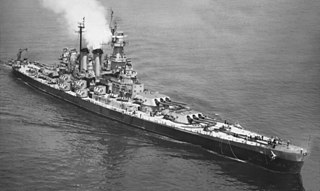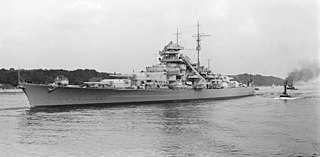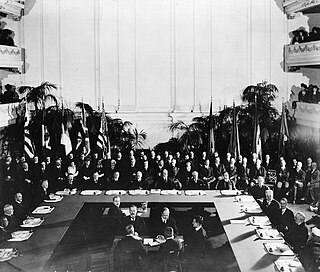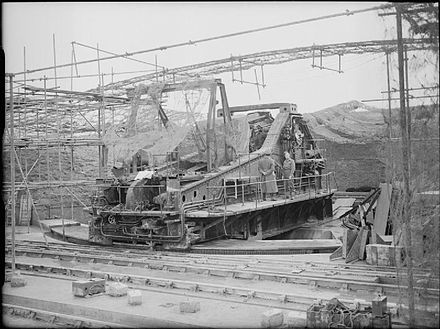
The Montana-class battleships were planned as successors of the Iowa class for the United States Navy, to be slower but larger, better armored, and with superior firepower. Five were approved for construction during World War II, but changes in wartime building priorities resulted in their cancellation in favor of the Essex-class aircraft carrier and Iowa class before any Montana class keels were laid.

The North Carolina class was a class of two fast battleships, North Carolina and Washington, built for the United States Navy in the late 1930s and early 1940s. The navy was originally uncertain whether the ships should be fast enough to counter the Japanese Kongō class, which was believed by the United States to be capable of 26 kn, or should sacrifice speed for additional firepower and armor. The Second London Naval Treaty's requirement that all capital ships have a standard displacement of under 35,000 LT (35,600 t) prevented the desired objectives from being fully realized within its limits, and the navy considered over fifty designs before one was chosen.

HMS Duke of York was a King George V-class battleship of the Royal Navy. Laid down in May 1937, the ship was constructed by John Brown and Company at Clydebank, Scotland, and commissioned into the Royal Navy on 4 November 1941, subsequently seeing combat service during the Second World War.

HMS Howe was the last of the five British King George V-class battleships of the Royal Navy. Built by Fairfield Shipbuilding and Engineering Company, she was laid down on 1 June 1937 and launched 9 April 1940. She was originally to have been named Beatty but this was changed to Howe, after Admiral Richard Howe. Howe was completed on 29 August 1942 after her building time was extended, as needed war supplies were diverted to work of a higher priority such as the construction and repair of both merchant ships and escort ships. Like her sister-ship Anson, Howe spent most of her career in the Arctic providing cover for Russian convoys.

The Iron Duke class was a group of four dreadnought battleships built for the British Royal Navy before the First World War. The class comprised four ships: Iron Duke, Marlborough, Benbow, and Emperor of India. Launched from October 1912 to November 1913, this was the third class of Royal Navy super-dreadnoughts. The ships were essentially repeats of the King George V-class battleships; they retained the same ten 13.5 inch (34.3 cm) guns in five twin gun turrets on the centreline. However, the Iron Dukes had improved armour and a more powerful secondary armament of 6-inch weapons instead of the 4-inch mounted on the earlier ships.

HMS Vanguard was a British fast battleship built during the Second World War and commissioned after the end of the war. She was the biggest and fastest of the Royal Navy's battleships, the last battleship to be launched in the world, and the only ship of her class.

The Yamato-class battleships were battleships of the Imperial Japanese Navy (IJN) constructed and operated during World War II. Displacing 72,000 long tons (73,000 t) at full load, the vessels were the heaviest battleships ever constructed. The class carried the largest naval artillery ever fitted to a warship, nine 460-millimetre naval guns, each capable of firing 1,460 kg (3,220 lb) shells over 42 km (26 mi). Two battleships of the class were completed, while a third (Shinano) was converted to an aircraft carrier during construction.

The Littorio class, also known as the Vittorio Veneto class, was a class of battleship of the Regia Marina, the Italian navy. The class was composed of four ships—Littorio, Vittorio Veneto, Roma, and Impero—but only the first three ships of the class were completed. Built between 1934 and 1942, they were the most modern battleships used by Italy during World War II. They were developed in response to the French Dunkerque-class battleships, and were armed with 381-millimeter (15.0 in) guns and had a top speed of 30 knots. The class's design was considered by the Spanish Navy, but the outbreak of World War II interrupted construction plans.

The Scharnhorst class were the first capital ships, referred to as either battleships or battlecruisers, built for Nazi Germany's Kriegsmarine after World War I. The class comprised two vessels: Scharnhorst and Gneisenau. Scharnhorst was launched first, and is considered to be the lead ship by some sources; they are also referred to as the Gneisenau class in some other sources, as Gneisenau was the first to be laid down and commissioned. They marked the beginning of German naval rearmament after the Treaty of Versailles. The ships were armed with nine 28 cm (11 in) SK C/34 guns in three triple turrets; plans to replace these with six 38 cm (15 in) SK C/34 guns in twin turrets were never realized.

The Lion class was a class of six fast battleships designed for the Royal Navy (RN) in the late 1930s. They were a larger, improved version of the preceding King George V class, with 16-inch (406 mm) guns. Only two ships were laid down before the Second World War began in September 1939 and a third was ordered during the war, but their construction was suspended shortly afterwards. The design was modified in light of war experience in 1942, but the two ships already begun were scrapped later in the year.

The BL 15-inch Mark I succeeded the BL 13.5 inch /45 naval gun. It was the first British 15-inch (381 mm) gun design and the most widely used and longest lasting of any British designs, and arguably the most efficient heavy gun ever developed by the Royal Navy. It was deployed on capital ships from 1915 until 1959, and was a key Royal Navy gun in both World Wars.
The P class was a planned group of twelve heavy cruisers of Nazi Germany's Kriegsmarine; they were the successor to the Deutschland-class cruisers. Design work began in 1937 and continued until 1939; at least twenty designs were submitted with nine of them being considered. There were three designs that were selected as the final contenders. One design was armed with six 283mm main guns in one triple turret forward and one more turret aft. It had two 150mm double secondary gun turrets as secondary armament with one being positioned above and just fore of the aft of the main 283mm main turret, and the other being in front and lower of the front main gun turret. This design had more beam than the other 2 designs. It also mounted 2 seaplanes on its fantail instead of the mid ship area. The final design was armed with six 28 cm (11 in) quick-firing guns in two triple turrets, as in the preceding Deutschland class. The ships were designated as Panzerschiff, and given the preliminary names P1–P12. They were an improved design over the preceding planned D-class cruisers, which had been canceled in 1934. Although the ships were already assigned to shipyards, construction never began on the P-class ships after the O-class battlecruiser design superseded them.

The QF 5.25-inch Mark I gun was the heaviest dual-purpose gun used by the Royal Navy during the Second World War. Although considered less than completely successful, it saw extensive service. 267 guns were built.

The D-class cruisers were a pair of German cruisers, classified as Panzerschiffe by the Kriegsmarine. The ships were improved versions of the preceding Deutschland-class cruisers, authorized by Adolf Hitler in 1933. They were intended to counter a new French naval construction program. Displacement increased to 20,000 long tons (20,000 t), but Hitler allowed only increases to armor, prohibiting additions to the ships' main battery. Only one of the two ships was laid down, but it was canceled less than five months after the keel was laid. It was determined that the designs should be enlarged to counter the new French Dunkerque-class ships. The construction contracts for both ships were superseded by the Scharnhorst-class battleships.

The Bismarck class was a pair of fast battleships built for Nazi Germany's Kriegsmarine shortly before the outbreak of World War II. The ships were the largest and most powerful warships built for the Kriegsmarine; displacing more than 41,000 metric tons normally, they were armed with a battery of eight 38 cm (15 in) guns and were capable of a top speed of 30 knots. Bismarck was laid down in July 1936 and completed in September 1940, while her sister Tirpitz's keel was laid in October 1936 and work finished in February 1941. The ships were ordered in response to the French Richelieu-class battleships and they were designed with the traditional role of engaging enemy battleships in home waters in mind, though the German naval command envisioned employing the ships as long-range commerce raiders against British shipping in the Atlantic Ocean. As such, their design represented strategic confusion that dominated German naval construction in the 1930s.

Scharnhorst was a German capital ship, alternatively described as a battleship or battlecruiser, of Nazi Germany's Kriegsmarine. She was the lead ship of her class, which included one other ship, Gneisenau. The ship was built at the Kriegsmarinewerft dockyard in Wilhelmshaven; she was laid down on 15 June 1935 and launched a year and four months later on 3 October 1936. Completed in January 1939, the ship was armed with a main battery of nine 28 cm (11 in) C/34 guns in three triple turrets. Plans to replace these weapons with six 38 cm (15 in) SK C/34 guns in twin turrets were never carried out.

The H class was a series of battleship designs for Nazi Germany's Kriegsmarine, which were intended to fulfill the requirements of Plan Z in the late 1930s and early 1940s. The first variation, "H-39," called for six ships to be built, essentially as enlarged Bismarck-class battleships with 40.6 cm (16.0 in) guns. The "H-41" design improved the "H-39" ship with still larger main guns, with eight 42 cm (16.5 in) weapons. Two subsequent plans, "H-42" and "H-43", increased the main battery yet again, with 48 cm (19 in) pieces, and the enormous "H-44" design ultimately resulted with 50.8 cm (20.0 in) guns. The ships ranged in size from the "H-39", which was 277.8 m long on a displacement of 56,444 t, to the "H-44", at 345 m on a displacement of 131,000 t. Most of the designs had a proposed top speed in excess of 30 knots (56 km/h).





























